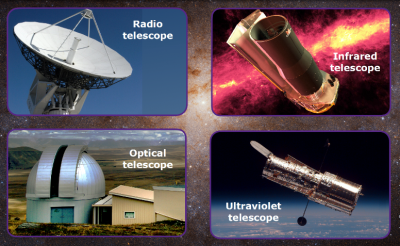
TELESCOPES
A telescope is the astronomer’s basic tool. It makes distant objects appear bigger and reveals their detail. Telescopes work by using a lens or mirror to collect light and bring it to a focus, producing an image. Reflectors, which use a mirror, are the most widely used type of telescope – the bigger the mirror, the more powerful the telescope and the better the view.
- NAKED-EYE VIEW The constellation of Orion is easily visible to the naked eye. On a dark, moonless night, a faint, fuzzy patch of light may be visible below the three stars of Orion’s belt. This is the Orion Nebula.
- THROUGH BINOCULARS The Orion Nebula is a massive star-forming cloud of gas and dust. The nebula becomes more obvious when looked at through binoculars — two low-powered telescopes working together. In standard binoculars the two main lenses are about 5 cm (2 in) wide and the image is magnified seven times.
- IMPROVED VIEW A more powerful telescope improves the view of the nebula. Across the world there are about 50 telescopes with mirrors 2-5 m (6.5-16.5 ft) across and another 20 with mirrors up to 10 m (33 ft) across. These large telescopes are located on mountain-top sites where the air is clear and still. Computerized controls adjust their position, keeping them tracked on their target as Earth turns.
- MEDIUM-SIZED TELESCOPE VIEW The nebula’s shape and form become visible through a telescope with a mirror about 20 cm (7.8 in) across. A camera attached to the telescope collects the light and records the image.
- X-RAY AND INFRARED VIEWS X-rays collected by the Chandra space telescope were used to make this image on the left, which shows the heart of the Orion Nebula. The image on the right shows the same area taken by the Spitzer infrared telescope. Clouds of dust heated by starlight show up in red.
- VIEW FROM SPACE Some telescopes collect forms of energy other than light, such as radio waves, X-rays, and infrared energy. Earth’s atmosphere prevents some of these from reaching Earth so they are collected by telescopes in space. This colour-enhanced image combines data from two space telescopes – Spitzer, which collects infrared waves, and Hubble, which collects both light and ultraviolet waves.
- HEART OF THE NEBULA Hubble’s 2.4-m (7.9-ft) wide mirror collected the light for this detailed view of the Orion Nebula’s bright central area. It includes the Trapezium, a cluster of ten young, brilliant stars that illuminate the nebula with their ultraviolet energy.
Picture Credit : Google



